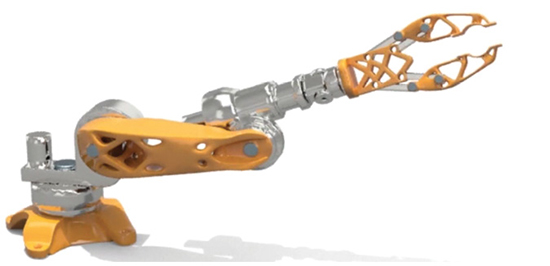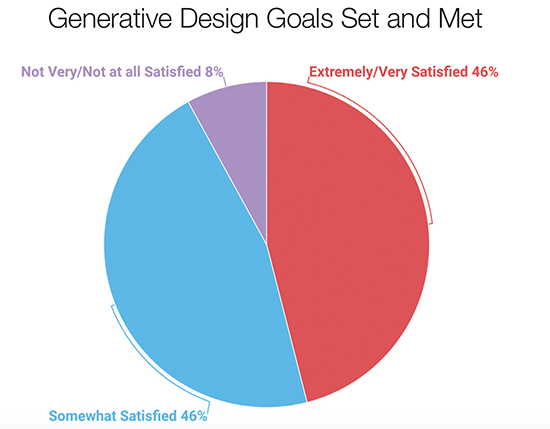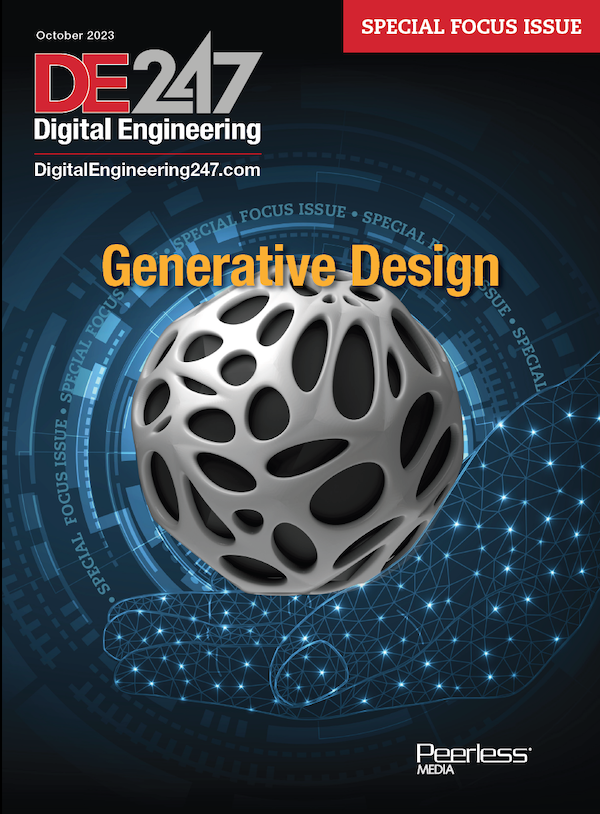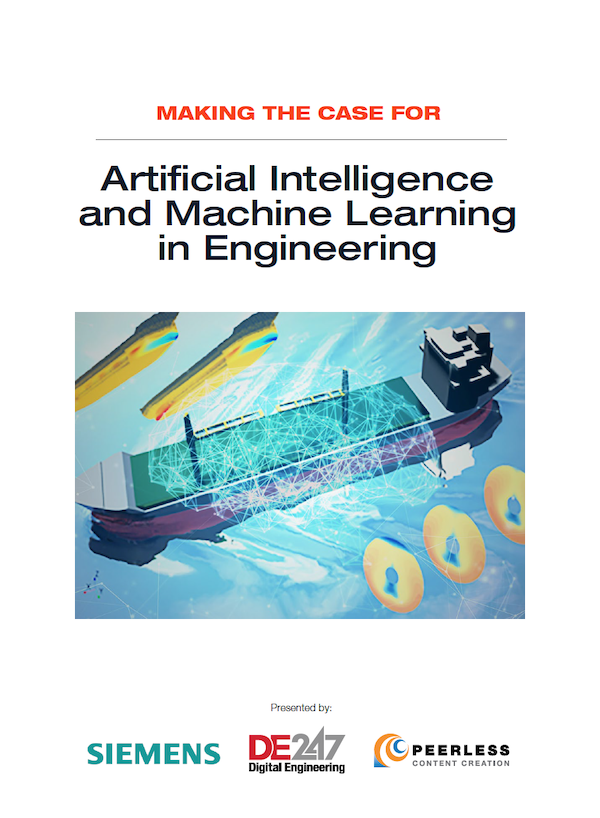Artificial Intelligence Beyond the Hype
Advancements in computing and research are making AI applications much more feasible.

Autodesk researchers are studying how artificial intelligence can be used with existing generative design technology. The swingarm (blue) was considered “impossible” to create using traditional design and manufacturing techniques. But an AI algorithm found a way by combining generative design for optimization with 3D printing methods. Image courtesy of Autodesk.
Latest News
December 1, 2018
If you frequently read technology news, there’s probably not a day that goes by without your reading something alarmist or disparaging about artificial intelligence (AI). Does one of IBM’s competitors think Watson is over-hyped? Is a politician worried about job loss? Is there a HAL in our future? Techno-celebrities including Elon Musk and the late Stephen Hawking have offered up various predictions not suitable for bedtime reading.
University of California, Berkeley, researcher Michael I. Jordan divides AI into three categories: 1. imitation, such as portrayed in science fiction; 2. augmentation, when AI and the other disciplines are used to extend and enhance human activity; and 3. connection, where technology intelligently processes massive real-time data streams, as required by autonomous vehicles. Jordan argues people are wasting their time on the imitation stage when there is so much real value to be achieved by using augmentation and connection.
Despite the hand-wringing, engineering software companies are taking Jordan’s advice. There is real value being created using AI and its related technologies, machine learning (ML), deep learning (DL) and even computationally intensive generative design (GD). Every major engineering and manufacturing software vendor and several startups are working on intelligent technologies with a wide variety of practical applications that will make boring science fiction but exciting accounting.
Intelligent Algorithms
“There is absolutely hype and excitement surrounding AI [in engineering],” says Rich Rovner, VP of Marketing at MathWorks. “There is more excitement than reality. But we are seeing people doing real design engineering with AI.” Some of the most important work today is in creating algorithmic models for engineering. “Data is the key; AI models are amazing but they need pre-processing. Our customers are applying domain-specific algorithms to processing their information,” he adds.

Altair Engineering is one of several companies involved in using models to generate data for training robots. The virtual robot can be assigned tasks; the deep learning algorithm can then study the robot’s movements to help automate future behavior. Image courtesy of Altair.
Such model development often gets folded into larger systems models, Rovner says. Building a predictive model of wind turbine development, for example, requires all the physics and components found in CAD and CAE models. Running simulations on the engineering model can then generate a dataset that an AI algorithm can use. “Use the simulation data to inject parameters into the model, to generate failures into the simulation,” Rovner says in the case of a wind turbine application. “At the end of the day, the power of AI comes with the ability to bring it into the engineering workflow.”
Rovner sees this early stage of AI in engineering as a time when companies are mostly becoming familiar with the processes. “We are shipping stuff now that will be used more in the days ahead,” Rovner says. Engineering teams can get started by creating “ground truths for their models” in such fields as autonomous vehicle guidance systems. One such application is semantic segmentation. Every pixel—yes, every pixel—in a single image from an autonomous vehicle guidance system is labeled to identify the object being depicted. “Then run the entire video through the [AI] software and it labels every frame in the video,” Rovner adds.
New Predictive Models
Use cases for AI are easier to create in retail or logistics because they have a constant stream of real-world data coming into the organization, says Fatma Kocer-Poyraz, VP of Engineering Analytics at Altair Engineering. “I tell engineering groups, ‘you need data, good data in quantity.’ Most people don’t realize how difficult it is to get this.” While historical data might work, there are too many considerations. “How strict were they in recording it? Do simulation results differ from one version to another?
“Still the best answer to ‘What is artificial intelligence?’ remains: ‘It is the opposite of natural stupidity.’”
— DE 2018 Survey Respondent
“Applying machine learning to engineering data is not something that can happen overnight,” Kocer-Poyraz says. “It is a long-term commitment. More and more in engineering, machine learning is adding value in engineering knowledge performance indicators. Machine learning means we can automate what the engineer does,” she adds, by looking at counter displacements, charts and graphs, and other data to make decisions based on stress and displacement fields.
A machine learning goal can be to train an algorithm to turn stress fields into one number, but “there is no one number to represent the issue or phenomenon; an engineer looks at the entire analysis result. But by working toward this goal, a new predictive model can emerge,” says Kocer-Poyraz. This model is one an engineer can use as part of the final analysis.
Altair’s recommendations for working with data are echoed by Thomas H. Davenport, author of a new book, “The AI Advantage” (MIT Press, 2018). He offers the following advice on making AI technologies practical:
- use AI to improve processes or products by automating the repetitive or structured aspects of design;
- look for “low-hanging fruit” opportunities to improve efficiency; and
- create smart products that “work alongside smart people.”
Smart Generative Design
Generative design is not new to engineering, but it sometimes comes up when the discussion turns to intelligent technology. Most generative design is brute force computation, says Mike Haley, senior director of machine intelligence at Autodesk. But a dataset created from using generative design can be recycled for machine learning applications. “Generative design work is design optimization,” Haley notes. If you start with a solid block of aluminum and apply both design optimization and CAE simulation, you have a dataset that can be used for machine learning to guide AI-based decisions about shaping that block into a part.
Haley says Autodesk is researching how to bring intelligent technologies into design using a multidisciplinary approach that mirrors its three markets of manufacturing, construction and media/entertainment content creation. One research effort involves how to bring aesthetics into design. Many manufacturers have a clear style aesthetic associated with their name. “It is a real design language, but hard to measure,” Haley says.

The No. 1 of reason why survey respondents implemented generative design software was to increase the productivity of engineers, analysts and designers. Of those, 92% report being at least somewhat satisfied with their progress toward realizing those productivity benefits.
When something is hard to measure or quantify, he says, “it becomes a good indicator that machine learning can help. AI software can learn style objectives” if engineers give the algorithms enough data to find commonalities. “It becomes guidance into style instead of shape or weight or other objectives.”
AI for CAD Software
nTopology is a young CAD company with a big mission: It wants to replace (or at least supplement) existing feature-based MCAD with an alternative called functional modeling. Founder Bradley Rothenberg says nTopology is using AI in research and development (R&D) to help its software automate the tedious aspects of design. “It is an immense multivariable problem,” Rothenberg says. “We allow AI to set up these experiments, to learn what are the important variables. This is a workflow approach, a pipeline.” nTopology uses AI iteratively: “There are variables which determine the structure you pick, the material you pick and the algorithms to create the required geometry.”
As with any project using intelligent technologies, data is key. The new CAD software is their initial infrastructure, “but we don’t have the data from the field yet,” which they need for the “big picture approach to the workflow.”
Rothenberg says they are getting data from a variety of sources. One way is to borrow from the idea of a digital thread, where there is a computational pipeline connecting all the parts of engineering. “If a part is going to be built with powder bed fusion, AI can be leveraged to find flaws as it is generated.” This is a new avenue for AI research, Rothenberg says. “AI algorithms for computer vision are well advanced, not so much for design.”
More Altair Coverage
More Autodesk Coverage
Subscribe to our FREE magazine, FREE email newsletters or both!
Latest News
About the Author
Randall S. Newton is principal analyst at Consilia Vektor, covering engineering technology. He has been part of the computer graphics industry in a variety of roles since 1985.
Follow DE






